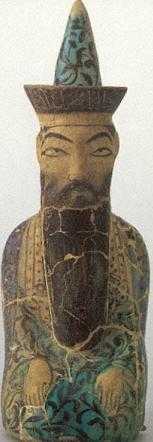1038 AD - 1063 AD
Great SeljuqTughril Beg 429 AH - 455 AH
The 1911 Encyclopedia
Seljuks, or Seljuqs, the name
of several Turkish dynasties issued from one family, which reigned over
Iarge parts of Asia in the 11th, 12th and 13th centuries of the
Christian era. The history of the Seljuks forms the first part of the
history of the Turkish empire. The first Seljuk rulers were Toghrul Beg, ChaIir Beg and Ibrahim
Niyal, the son of Mikail, the son of Seljuk, the son of Tulal, or Tuq
(also styled Timuryalil, iron bow ). They belonged to the Turkish tribe
of the Ghuzz which traced its lineage to Oghuz, the famous eponymic
hero not only of this but of all Turkish tribes. There arose, however,
at some undefined epoch a strife on the part of this tribe and some
others with the rest of the Turks, because, as the latter allege,
Ghuzz, the son (or grandson) of Yafeth (Japhet), the son of Nub (Noah),
had stolen the genuine rain-stone, which Turk, also a son of Yafeth,
had inherited from his father. By this party, as appears from this
tradition, the Ghuzz were not considered to be genuine Turks, but to be
Turkmans (that is according to a popular etymology, resembling Turks).
But the native tradition of the Ghuzz was unquestionably right, as they
spoke a pure Turkish dialect. The fact, however, remains that there
existed a certain animosity between the Ghuzz and their allies and the
rest of the Turks, which increased as the former became converted to
Islam (in the course of the 4th century of the Flight). The Ghuzz were
settled at that time in Transoxiana, especially at Jand, a well-known
city on the banks of the Jaxartes, not far from its mouth.Some of them served in the armies of the Ghaznavids Sabuktagin
(Sebuktegin) and Mabmud (997-1030); but the Seljuks, a royal family
among them, had various relations with the reigning princes of
Transoxiana and Khwarizm, which cannot be narated here. But, friends or
foes, the Ghuzz became a serious danger to the adjoining Mahommedan
provinces from their predatory habits and continual raids, and the more
so as they were very numerous.
It may suffice to mention that, under the leadership of PIgu Arslan Israil, they crossed the Oxus and spread over the eastern provinces of Persia, everywhere plundering and destroying. The imprisonment of this chieftain by Masd, the son and successor of Mabmud, was of no avail: it only furnished his nephews with a ready pretext to cross the Oxus likewise in arms against the Ghaznavids. We pass over their first confficts and the unsuccessful agreements that were attempted, to mention the decisive battle near Merv (1040), in which Masd was totally defeated and driven back to Ghazni (Ghazna). Persia now lay open to the victors, who proclaimed themselves independent at Merv (which became from that time the official capital of the principal branch of the Seljuks), and acknowledged Toghrul Beg as chief of the whole family. After this victory the three princes Toghrul Beg, Chalir Beg and Ibrahim Niyal separated in different directions and conquered the Mahommedan provinces, east of the Tigris; the last named, after conquering Hamadan and the province of Jebel (Irak i Ajami), penetrated as early as 1048, with fresh Ghuzz troops, into Armenia and reached Manzikert, Erzerm and Trebizond. This excited the jealousy of Toghrul Beg, who summoned him to give up Hamadn and the fortresses of Jebel; but Ibrahim refused, and the progress of the Seljukian arms was for some time checked by internal discordan everrecurring event in their history. Ibrahim was, however, compelled to submit. At this time the power of
Qaim, the Abbasid caliph of Bagdad was reduced to a mere shadow, as the
Shiite dynasty of the Buyids and afterwards his more formidable
Fatimite rivals had left him almost wholly destitute of authority. The
real ruler at Bagdad was a Turk named Basasiri, lieutenant of the last
Buyid, Malik-ar-Rabim. Nothing could, therefore, be more acceptable to
the caliph than the protection of the orthodox Toghrul Beg, whose name
was read in the official prayer (khotba) as early as 1050. At the end
of the same year (1055) the Seljuk entered the city and after a tumult
seized the person of Malik-ar-Rabim. Basasiri had the good fortune to
be out of his reach; after acknowledging the right of the Fatimites, he
gathered fresh troops and incited Ibrahim Niyal to rebel again, and he
succeeded so far that he re-entered Bagdad at the close of 1058. The
next year, however, Toghrul Beg got rid of both his antagonists,
Ibrahim being taken prisoner and strangled with the bowstring, while
Basasiri fell in battle. Toghrul Beg now re-entered Bagdad,
re-established the caliph, and was betrothed to his daughter, but died
before the consummation of the nuptials (September 1063).
|